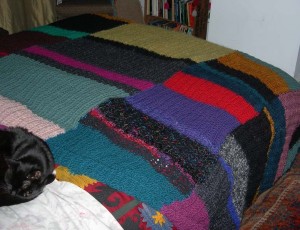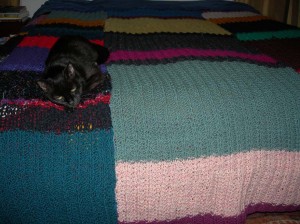There are lots of ways to clean out a closet. Partly, it depends on what is in the closet. Per my earlier post about freecycle, I think that part of the practice of sauca or cleanliness, is making sure that the hidden parts of our homes are not overfilled with stuff we do not use. Cleaning out the closet, does not mean throwing everything out. It can mean creatively rethinking where things should be and how we should use them. It also means for every artist, cook, crafts person, periodically making use of all those things you picked up or saved because they would be of use in something.
I was raised to save things that possibly could be used later, and to try and make every scrap usable. I was taught this because my father was born in 1929 and my mother in 1936 of Jewish peasant immigrants. Now, we are re-learning how to maximize the use of objects and minimize waste for ecological, rather than financial reasons, though the two are inextricably intertwined. As the recession progresses, it will be interesting to see whether financial constriction will foster more environmentally conscious living.
About four years ago, when I was engaged in a periodic review of what was in the hall closet, I came upon my big box of leftover yarn. In the late eighties and early nineties, I traveled extensively for business, and spent many hours in airports and evenings in hotels. I found it comforting to have a lapful of mohair, homespun, or other delicious to touch yarn. Airport security was less invasive, and it was possible to knit in the airport and take knitting needles on board the airplane. As I love working with multiple colors, that resulted in a leftover skeins from each project. Over a 10-15 year period, even with only a couple of aborted projects and no yarn bought for imagined future projects (unlike a really serious knitter), I ended up with enough yarn for a queen-sized blanket (shocking, really). As you can see, I designed it like a crazy quilt. It took an educated sense of color and line — imagine this as a painting or pastel and you can see the influence of the Washington Color School, but it did not require much in the way of knitting skills (the whole blanket knit in panels of “mistake rib” — (k2, p2), end k2, p1 — about 50,000 times). The patch of fire engine red and the grape juice purple next to it, came from my friend Sara, who is a fabulously talented knitter. I felt the need for those colors, so we swapped for some of the teal and green that I had.
The blanket took almost four years to knit because I only did it in fits and starts. Finally, last year, I decided that I needed to finish it in time for Becky be able to curl up on it. As you can see, she thinks it is great. Now my closet is not stuffed with a big box of yarn, I have an extra warm blanket that helps me keep the house just a little cooler, I made a thing of beauty where I might have been tempted to go out and buy something new, and Becky has a new happy spot.




Nice blanket Elizabeth! Spot the fire engine red huh? Glad they worked out, this truly is a work of art.
What’s next – Socks on Circulars I would guess… try to find Cat Bordhi’s book, it may by in the local libraries. I know Amazon have it. Then you can get yourself started with manageable Metro knitting – great for commuter trips and not to intrusive to the person sitting next to you. Good conversation starter too.
Great Blog – when I update mine we can link. Namaste.
Absolutely beautiful 🙂 I love the mix of colors. I stumbled upon this when I was looking for your pattern for hand warmers. Now I am inspired to make a crazy quilt…I’ll let you know how it goes.